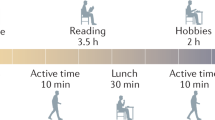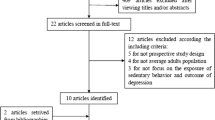Abstract
Obesity is a major health challenge facing the modern world. Some evidence points to obesity itself as the main driver of premature mortality. We propose that this view is oversimplified. For example, high levels of physical activity and cardiorespiratory fitness are associated with lower mortality, even in those who are overweight or obese. To address this issue, we combine epidemiological and physiological evidence in a new paradigm that integrates excess calorie intake, sedentary behavior, and a maladaptive response to stress. Human physiology is optimized to allow large distances to be covered on foot every day in order to find enough food to sustain brain metabolism. Furthermore, when the body is immobilized by an injury, it triggers efficient life-saving metabolic and inflammatory responses. Both these critical adaptations are, however, confounded by a sedentary lifestyle. The implications of these issues for clinical trial design and epidemiologic data analysis are discussed in this article.
This is a preview of subscription content, access via your institution
Access options
Subscribe to this journal
Receive 12 print issues and online access
$209.00 per year
only $17.42 per issue
Buy this article
- Purchase on Springer Link
- Instant access to full article PDF
Prices may be subject to local taxes which are calculated during checkout


Similar content being viewed by others
References
Janssen, I., Katzmarzyk, P. T. & Ross, R. Body mass index is inversely related to mortality in older people after adjustment for waist circumference. J. Am. Geriatr. Soc. 53, 2112–2118 (2005).
Oreopoulos, A. et al. The relationship between body mass index, treatment, and mortality in patients with established coronary artery disease: a report from APPROACH. Eur. Heart J. 30, 2584–2592 (2009).
Kalantar-Zadeh, K., Block, G., Horwich, T. & Fonarow, G. C. Reverse epidemiology of conventional cardiovascular risk factors in patients with chronic heart failure. J. Am. Coll. Cardiol. 43, 1439–1444 (2004).
Neubauer, S. The failing heart—an engine out of fuel. N. Engl. J. Med. 356, 1140–1151 (2007).
Kodama, S. et al. Cardiorespiratory fitness as a quantitative predictor of all-cause mortality and cardiovascular events in healthy men and women: a meta-analysis. JAMA 301, 2024–2035 (2009).
Byberg, L. et al. Total mortality after changes in leisure time physical activity in 50 year old men: 35 year follow-up of population based cohort. BMJ 338, b688 (2009).
Kokkinos, P. et al. Exercise capacity and mortality in black and white men. Circulation 117, 614–622 (2008).
Katzmarzyk, P. T., Church, T. S., Janssen, I., Ross, R. & Blair, S. N. Metabolic syndrome, obesity, and mortality: impact of cardiorespiratory fitness. Diabetes Care 28, 391–397 (2005).
Gulati, M. et al. Exercise capacity and the risk of death in women: the St James Women Take Heart Project. Circulation 108, 1554–1559 (2003).
Laukkanen, J. A. et al. Determinants of cardiorespiratory fitness in men aged 42 to 60 years with and without cardiovascular disease. Am. J. Cardiol. 103, 1598–1604 (2009).
Blair, S. N. & Church, T. S. The fitness, obesity, and health equation: is physical activity the common denominator? JAMA 292, 1232–1234 (2004).
Booth, F. W., Laye, M. J., Lees, S. J., Rector, R. S. & Thyfault, J. P. Reduced physical activity and risk of chronic disease: the biology behind the consequences. Eur. J. Appl. Physiol. 102, 381–390 (2008).
Bramble, D. M. & Lieberman, D. E. Endurance running and the evolution of Homo. Nature 432, 345–352 (2004).
Boulé, N. G. et al. Effects of exercise training on glucose homeostasis: the HERITAGE Family Study. Diabetes Care 28, 108–114 (2005).
Urso, M. L., Scrimgeour, A. G., Chen, Y. W., Thompson, P. D. & Clarkson, P. M. Analysis of human skeletal muscle after 48 h immobilization reveals alterations in mRNA and protein for extracellular matrix components. J. Appl. Physiol. 101, 1136–1148 (2006).
Vaidyula, V. R. et al. Effects of hyperglycemia and hyperinsulinemia on circulating tissue factor procoagulant activity and platelet CD40 ligand. Diabetes 55, 202–208 (2006).
Ross, R. & Bradshaw, A. J. The future of obesity reduction: beyond weight loss. Nat. Rev. Endocrinol. 5, 319–325 (2009).
Pou, K. M. et al. Visceral and subcutaneous adipose tissue volumes are cross-sectionally related to markers of inflammation and oxidative stress: the Framingham Heart Study. Circulation 116, 1234–1241 (2007).
Björntorp, P. Do stress reactions cause abdominal obesity and comorbidities? Obes. Rev. 2, 73–86 (2001).
Centers for Disease Control and Prevention. Prevalence of regular physical activity among adults—United States, 2001 and 2005. Morb. Mortal. Wkly Rep. 56, 1209–1212 (2007).
Hu, F. B., Li, T. Y., Colditz, G. A., Willett, W. C. & Manson, J. E. Television watching and other sedentary behaviors in relation to risk of obesity and type 2 diabetes mellitus in women. JAMA 289, 1785–1791 (2003).
Healy, G. N. et al. Breaks in sedentary time: beneficial associations with metabolic risk. Diabetes Care 31, 661–666 (2008).
Hamilton, M. T., Hamilton, D. G. & Zderic, T. W. Role of low energy expenditure and sitting in obesity, metabolic syndrome, type 2 diabetes, and cardiovascular disease. Diabetes 56, 2655–2667 (2007).
Katan, M. B. & Ludwig, D. S. Extra calories cause weight gain—but how much? JAMA 303, 65–66 (2010).
Kalantar-Zadeh, K. et al. Risk factor paradox in wasting diseases. Curr. Opin. Clin. Nutr. Metab. Care 10, 433–442 (2007).
Unger, R. H. Reinventing type 2 diabetes: pathogenesis, treatment, and prevention. JAMA 299, 1185–1187 (2008).
Colman, R. J. et al. Caloric restriction delays disease onset and mortality in rhesus monkeys. Science 325, 201–204 (2009).
Laurier, D., Nguyen, P. C., Cazelles, B. & Segond, P. Estimation of CHD risk in a French working population using a modified Framingham model. The PCV-METRA Group. J. Clin. Epidemiol. 47, 1353–1364 (1994).
Arsenault, B. J. et al. Physical activity, the Framingham risk score and risk of coronary heart disease in men and women of the EPIC-Norfolk study. Atherosclerosis 209, 261–265 (2010).
Andersen, L. B., Anderssen, S. A. & Saltin, B. Letter regarding article by Christou et al, “Fatness is a better predictor of cardiovascular disease risk factor profile than aerobic fitness in healthy men”. Circulation 112, e253–e254 (2005).
Johnson, R. K. et al. Dietary sugars intake and cardiovascular health: a scientific statement from the American Heart Association. Circulation 120, 1011–1020 (2009).
Malik, V. S., Popkin, B. M., Bray, G. A., Després, J. P. & Hu, F. B. Sugar-sweetened beverages, obesity, type 2 diabetes mellitus, and cardiovascular disease risk. Circulation 121, 1356–1364 (2010).
Caspersen, C. J., Powell, K. E. & Christenson, G. M. Physical activity, exercise, and physical fitness: definitions and distinctions for health-related research. Public Health Rep. 100, 126–131 (1985).
Acknowledgements
We thank Bill Piper for his English language editorial assistance.
Author information
Authors and Affiliations
Corresponding author
Ethics declarations
Competing interests
The authors declare no competing financial interests.
Rights and permissions
About this article
Cite this article
Charansonney, O., Després, JP. Disease prevention—should we target obesity or sedentary lifestyle?. Nat Rev Cardiol 7, 468–472 (2010). https://doi.org/10.1038/nrcardio.2010.68
Published:
Issue Date:
DOI: https://doi.org/10.1038/nrcardio.2010.68
This article is cited by
-
Association between self-reported sedentary behavior and health-related quality of life among infertile women with polycystic ovary syndrome
BMC Women's Health (2023)
-
Cardiovascular benefits independent of body mass loss in overweight individuals after exercise program
Sport Sciences for Health (2019)
-
Correlates of physical activity and sedentary time in young adults: the Western Australian Pregnancy Cohort (Raine) Study
BMC Public Health (2018)
-
Effectiveness of a community-based intervention for weight loss on cardiometabolic risk factors among overweight and obese women in a low socio-economic urban community: findings of the MyBFF@home
BMC Women's Health (2018)
-
Exercise training improves sleep pattern and metabolic profile in elderly people in a time-dependent manner
Lipids in Health and Disease (2011)



